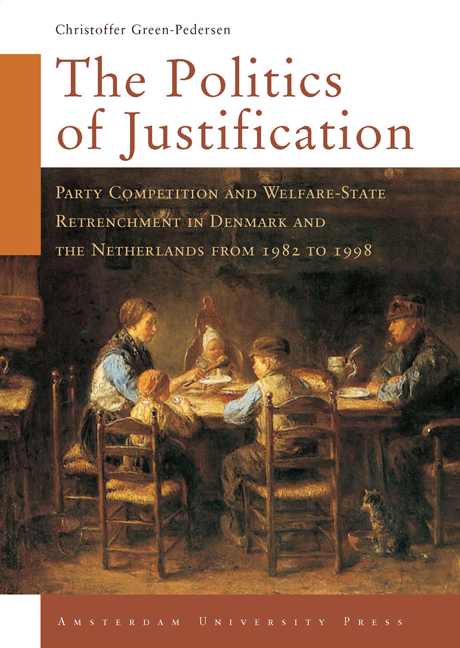 The Politics of Justification
The Politics of Justification Book contents
- Frontmatter
- Acknowledgments
- Contents
- List of Abbreviations
- 1 Introduction
- 2 From Theories of Expansion to Theories of Retrenchment
- 3 Framework for Government Choice on Retrenchment
- 4 Research Strategy and Research Design
- 5 Retrenchments in Denmark and the Netherlands
- 6 Dutch Politics and Welfare-State Retrenchment.How Party Competition Produced Consensus
- 7 Danish Politics and Welfare-State Retrenchment:The Difficulties of a Right-Wing Government and the Possibilities of a Left-Wing Government
- 8 The Evidence on Balance and some Quibbles
- 9 Party Politics Matter – Summary and Implications
- Appendix
- Summary
- Notes
- References
- Index
7 - Danish Politics and Welfare-State Retrenchment:The Difficulties of a Right-Wing Government and the Possibilities of a Left-Wing Government
Published online by Cambridge University Press: 15 January 2021
- Frontmatter
- Acknowledgments
- Contents
- List of Abbreviations
- 1 Introduction
- 2 From Theories of Expansion to Theories of Retrenchment
- 3 Framework for Government Choice on Retrenchment
- 4 Research Strategy and Research Design
- 5 Retrenchments in Denmark and the Netherlands
- 6 Dutch Politics and Welfare-State Retrenchment.How Party Competition Produced Consensus
- 7 Danish Politics and Welfare-State Retrenchment:The Difficulties of a Right-Wing Government and the Possibilities of a Left-Wing Government
- 8 The Evidence on Balance and some Quibbles
- 9 Party Politics Matter – Summary and Implications
- Appendix
- Summary
- Notes
- References
- Index
Summary
This chapter aims to draw a Danish parallel to the Dutch case study of the previous chapter. The chapter begins with a short section on Danish politics and the welfare state in the years preceding 1982, especially the period 1973 to 1982. A second section explores the period of right-wing rule from 1982 to 1993. The third section addresses the period of social democratic-led governments from 1993 to 1998. Finally, some general conclusions are given about the Danish case.
Landslide election and fumbling socio-economic policy
Danish politics have historically been dominated by a left wing and a rightwing bloc. The former has largely been identical to the Social Democratic Party (Socialdemokratiet). The latter consists of the Conservative Party (Det Konservative Folkeparti) and the Liberals (Venstre), an agrarian party gradually transformed into a liberal party. The Social Liberals (Det Radikale Venstre) held the balance of power and hence decided which bloc should govern the country. For the first three post-war decades, primarily the Social Democrats were in power. At times, the Social Democrats ruled in majority governments including the Social Liberals, and at other times they formed single-party minority governments (Pedersen 1987; Damgaard 1992; Christensen 2000). The only major change to this pattern before 1973 was the establishment of the non-communist, moderate left-wing party, the Socialist People's Party (Socialistisk Folkeparti, SF), and its entrance into parliament in 1960. During the two periods 1966-1968 and 1971- 1973, the Social Democrats were able to rely on the support from sf. The Social Liberals then chose to support the right-wing bloc (op. cit.).
The 1973 election changed this situation as a number of new parties gained seats in parliament, among which the largest one was the right-wing Progress Party (Fremskridtspartiet) gaining around 16% of the votes. Among the other newcomers were two centre parties, the Centre Democrats (Centrumdemokaterne, CD) and the Christian People's Party (Kristeligt Folkeparti). In addition, the Communist Party (Danmarks Kommunistiske Parti) and the Justice Party (Retsforbundet) regained representation (Pedersen 1988). The 1973 earthquake election did not change the bloc nature of Danish party competition, yet it complicated Danish politics.
- Type
- Chapter
- Information
- The Politics of JustificationParty Competition and Welfare-State Retrenchment in Denmark and the Netherlands from 1982 to 1998, pp. 111 - 130Publisher: Amsterdam University PressPrint publication year: 2002
